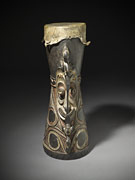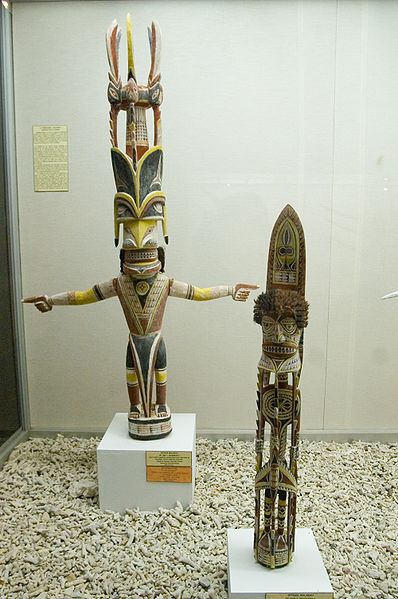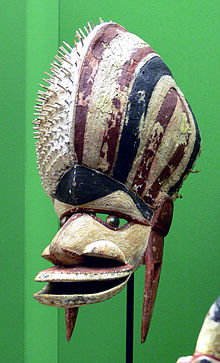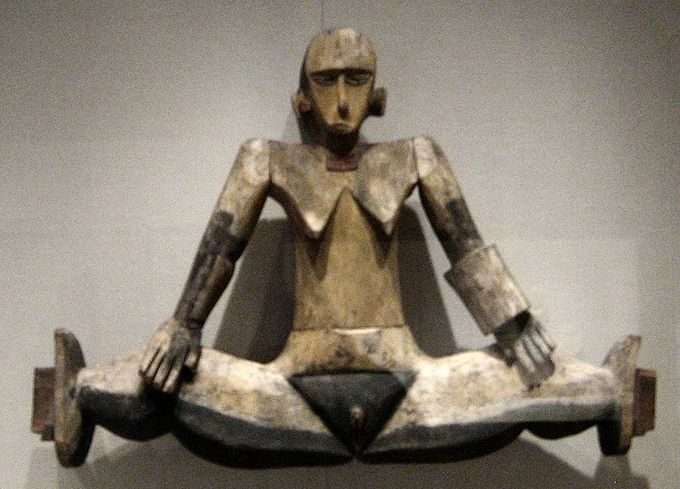26.3: Wood Carving in Oceania
- Page ID
- 53109
\( \newcommand{\vecs}[1]{\overset { \scriptstyle \rightharpoonup} {\mathbf{#1}} } \)
\( \newcommand{\vecd}[1]{\overset{-\!-\!\rightharpoonup}{\vphantom{a}\smash {#1}}} \)
\( \newcommand{\dsum}{\displaystyle\sum\limits} \)
\( \newcommand{\dint}{\displaystyle\int\limits} \)
\( \newcommand{\dlim}{\displaystyle\lim\limits} \)
\( \newcommand{\id}{\mathrm{id}}\) \( \newcommand{\Span}{\mathrm{span}}\)
( \newcommand{\kernel}{\mathrm{null}\,}\) \( \newcommand{\range}{\mathrm{range}\,}\)
\( \newcommand{\RealPart}{\mathrm{Re}}\) \( \newcommand{\ImaginaryPart}{\mathrm{Im}}\)
\( \newcommand{\Argument}{\mathrm{Arg}}\) \( \newcommand{\norm}[1]{\| #1 \|}\)
\( \newcommand{\inner}[2]{\langle #1, #2 \rangle}\)
\( \newcommand{\Span}{\mathrm{span}}\)
\( \newcommand{\id}{\mathrm{id}}\)
\( \newcommand{\Span}{\mathrm{span}}\)
\( \newcommand{\kernel}{\mathrm{null}\,}\)
\( \newcommand{\range}{\mathrm{range}\,}\)
\( \newcommand{\RealPart}{\mathrm{Re}}\)
\( \newcommand{\ImaginaryPart}{\mathrm{Im}}\)
\( \newcommand{\Argument}{\mathrm{Arg}}\)
\( \newcommand{\norm}[1]{\| #1 \|}\)
\( \newcommand{\inner}[2]{\langle #1, #2 \rangle}\)
\( \newcommand{\Span}{\mathrm{span}}\) \( \newcommand{\AA}{\unicode[.8,0]{x212B}}\)
\( \newcommand{\vectorA}[1]{\vec{#1}} % arrow\)
\( \newcommand{\vectorAt}[1]{\vec{\text{#1}}} % arrow\)
\( \newcommand{\vectorB}[1]{\overset { \scriptstyle \rightharpoonup} {\mathbf{#1}} } \)
\( \newcommand{\vectorC}[1]{\textbf{#1}} \)
\( \newcommand{\vectorD}[1]{\overrightarrow{#1}} \)
\( \newcommand{\vectorDt}[1]{\overrightarrow{\text{#1}}} \)
\( \newcommand{\vectE}[1]{\overset{-\!-\!\rightharpoonup}{\vphantom{a}\smash{\mathbf {#1}}}} \)
\( \newcommand{\vecs}[1]{\overset { \scriptstyle \rightharpoonup} {\mathbf{#1}} } \)
\( \newcommand{\vecd}[1]{\overset{-\!-\!\rightharpoonup}{\vphantom{a}\smash {#1}}} \)
\(\newcommand{\avec}{\mathbf a}\) \(\newcommand{\bvec}{\mathbf b}\) \(\newcommand{\cvec}{\mathbf c}\) \(\newcommand{\dvec}{\mathbf d}\) \(\newcommand{\dtil}{\widetilde{\mathbf d}}\) \(\newcommand{\evec}{\mathbf e}\) \(\newcommand{\fvec}{\mathbf f}\) \(\newcommand{\nvec}{\mathbf n}\) \(\newcommand{\pvec}{\mathbf p}\) \(\newcommand{\qvec}{\mathbf q}\) \(\newcommand{\svec}{\mathbf s}\) \(\newcommand{\tvec}{\mathbf t}\) \(\newcommand{\uvec}{\mathbf u}\) \(\newcommand{\vvec}{\mathbf v}\) \(\newcommand{\wvec}{\mathbf w}\) \(\newcommand{\xvec}{\mathbf x}\) \(\newcommand{\yvec}{\mathbf y}\) \(\newcommand{\zvec}{\mathbf z}\) \(\newcommand{\rvec}{\mathbf r}\) \(\newcommand{\mvec}{\mathbf m}\) \(\newcommand{\zerovec}{\mathbf 0}\) \(\newcommand{\onevec}{\mathbf 1}\) \(\newcommand{\real}{\mathbb R}\) \(\newcommand{\twovec}[2]{\left[\begin{array}{r}#1 \\ #2 \end{array}\right]}\) \(\newcommand{\ctwovec}[2]{\left[\begin{array}{c}#1 \\ #2 \end{array}\right]}\) \(\newcommand{\threevec}[3]{\left[\begin{array}{r}#1 \\ #2 \\ #3 \end{array}\right]}\) \(\newcommand{\cthreevec}[3]{\left[\begin{array}{c}#1 \\ #2 \\ #3 \end{array}\right]}\) \(\newcommand{\fourvec}[4]{\left[\begin{array}{r}#1 \\ #2 \\ #3 \\ #4 \end{array}\right]}\) \(\newcommand{\cfourvec}[4]{\left[\begin{array}{c}#1 \\ #2 \\ #3 \\ #4 \end{array}\right]}\) \(\newcommand{\fivevec}[5]{\left[\begin{array}{r}#1 \\ #2 \\ #3 \\ #4 \\ #5 \\ \end{array}\right]}\) \(\newcommand{\cfivevec}[5]{\left[\begin{array}{c}#1 \\ #2 \\ #3 \\ #4 \\ #5 \\ \end{array}\right]}\) \(\newcommand{\mattwo}[4]{\left[\begin{array}{rr}#1 \amp #2 \\ #3 \amp #4 \\ \end{array}\right]}\) \(\newcommand{\laspan}[1]{\text{Span}\{#1\}}\) \(\newcommand{\bcal}{\cal B}\) \(\newcommand{\ccal}{\cal C}\) \(\newcommand{\scal}{\cal S}\) \(\newcommand{\wcal}{\cal W}\) \(\newcommand{\ecal}{\cal E}\) \(\newcommand{\coords}[2]{\left\{#1\right\}_{#2}}\) \(\newcommand{\gray}[1]{\color{gray}{#1}}\) \(\newcommand{\lgray}[1]{\color{lightgray}{#1}}\) \(\newcommand{\rank}{\operatorname{rank}}\) \(\newcommand{\row}{\text{Row}}\) \(\newcommand{\col}{\text{Col}}\) \(\renewcommand{\row}{\text{Row}}\) \(\newcommand{\nul}{\text{Nul}}\) \(\newcommand{\var}{\text{Var}}\) \(\newcommand{\corr}{\text{corr}}\) \(\newcommand{\len}[1]{\left|#1\right|}\) \(\newcommand{\bbar}{\overline{\bvec}}\) \(\newcommand{\bhat}{\widehat{\bvec}}\) \(\newcommand{\bperp}{\bvec^\perp}\) \(\newcommand{\xhat}{\widehat{\xvec}}\) \(\newcommand{\vhat}{\widehat{\vvec}}\) \(\newcommand{\uhat}{\widehat{\uvec}}\) \(\newcommand{\what}{\widehat{\wvec}}\) \(\newcommand{\Sighat}{\widehat{\Sigma}}\) \(\newcommand{\lt}{<}\) \(\newcommand{\gt}{>}\) \(\newcommand{\amp}{&}\) \(\definecolor{fillinmathshade}{gray}{0.9}\)New Guinean Wood Carvings
With its diverse cultural heritage, the island of New Guinea holds some of the most striking art in all of Oceania.
Describe the ancient stone figures, famous wood carvings, and the work of contemporary artists of New Guinea
Key Points
- The earliest examples of art in New Guinea are thought to have appeared around 1500 BCE in the form of early Oceanic rock sculptures, found mainly in the highlands.
- The region is most famously known today for its elaborate wood carvings, including sculptures, masks, canoes, drums, and storyboards.
- The Asmat, an ethnic group of New Guinea, are known for their elaborate wood carvings in the form of bisj poles, which are designed to honor ancestors.The latter half of the 19th century saw a decline of some traditional art forms as westernization began taking its toll on the area.
- However, the 20th and 21st centuries have seen a comeback in traditional New Guinean art and a burgeoning movement of contemporary artists such as Mathias Kauage.
Key Terms
- highlands: A mountainous or hilly section of a country.
- oceanic art: The artistic traditions of the people indigenous to Australia, New Zealand, and the Pacific Islands, including Melanesia, Micronesia, and Polynesia.
- headhunting: The practice of taking and preserving a person’s head after killing the person.
Overview: Art in New Guinea
New Guinean art is many-sided and complex. The sheer diversity of cultural groups existing in the region have resulted in many unique styles of cultural expression, from art and architecture to music and weaponry.
Ancient Sculptures
Traditional art of New Guinea falls under the greater classification of Oceanic art —art made by the native peoples of the Pacific Islands and Australia. The earliest examples of art in New Guinea are thought to have appeared around 1500 BCE in the form of early Oceanic sculptures. These sculptures, found throughout the island but mostly in the mountainous highlands, first appeared as stone figures that took the shape of mortars, pestles, or freestanding figures. Imagery including birds, human heads, or geometric patterns were often carved onto the tops of pestles or mortars or into the freestanding figures. While the original significance of these pieces is unknown, they may have been used in the context of rituals.
Wood Carvings
The region of New Guinea is perhaps most famously known for its tradition in wood carvings, which are especially prevalent along the Sepik River of Papau New Guinea (an Oceanian country that occupies the eastern half of the island of New Guinea and its offshore islands in Melanesia). Elaborate carvings often took the form of sculptures, masks, canoes, drums, and storyboards, many of which are in overseas museums today.

The Bisj Poles of the Asmat
The Asmat are an ethnic group of New Guinea, residing in the Papua province. They have one of the most well-known woodcarving traditions in the Pacific, and their art is sought by collectors worldwide. Asmat art consists of elaborate stylized wood carvings, such as the bisj pole, that are designed to honor ancestors.
A bisj pole is a ritual artifact that can be erected as an act of revenge, to pay homage to the ancestors, to calm the spirits of the deceased, and to bring harmony and spiritual strength to the community. Carved out of a single piece of a wild nutmeg tree, bisj poles can reach heights of up to 25 feet. Their carvings depict human figures standing on top of each other, as well as animal figures and carvings in the shape of a canoe prow. Bisj poles are carved by Asmat religious carvers (known as wow-ipits) after a member of their tribe or community had been killed by an enemy tribe. The Asmat believed that if a member of the community had been killed, his spirit would linger in the village and cause disharmony. Bisj poles were erected in order to satisfy these spirits and send them to the afterlife (known as Safan) across the sea.
Many rituals involved the bisj poles, including dancing, masquerading, singing, and headhunting —all performed by men. Bisj poles often had a receptacle at the base that was meant to hold the heads of enemies taken on headhunting missions. Canoe prow symbols represented a metaphorical boat that would take the deceased spirits away to the afterlife; the human figures would represent deceased ancestors. Although the practice of headhunting ended in the Asmat region in the 1970s, the poles are still used in rituals today.

Development of Art Over Time
New Guinean artistic tradition continued even with increasing trade and interaction with European explorers through the 17th and 18th centuries. The latter half of the 19th century saw a decline of some traditional art forms as westernization began taking its toll on the area. In the 20th century, however, New Guinean and other Oceanic art began making a comeback.
The first wave of contemporary New Guinean artists included Mathias Kauage,Timothy Akis, Jakupa Ako, and Joe Nalo. Kauage, whose work included drawing, painting, and woodcuts, won Australia’s Blake Prize for religious art; four of his works are in the Glasgow Museum of Modern Art, and he had a solo show in 2005 at the Horniman Museum entitled “Kauage’s Visions: Art from Papua New Guinea.” Other noted Papua New Guinean visual artists include Larry Santana, Martin Morububuna, and Heso Kiwi.
Malagan Carvings
New Ireland, a large island in Melanesia, is most known for its elaborate wooden carvings used in traditional rituals and ceremonies.
Describe the malagan carvings, tatanua masks, and kulap sculptures of New Ireland
Key Points
- New Ireland has a rich cultural history heavily influenced by Oceanic art.
- The most well-known art from this region includes malagan carvings, tatanua masks, and kulap sculptures used in traditional ceremonies, such as the funerary malagan ritual.
- Wooden malagan carvings were used during the rituals they are named after to honor the deceased; they are now world-famous and held in museums around the world.
- Tatanua masks, carved from wood and elaborately painted and decorated, are often worn by ceremonial dancers during malagan rituals.
- Kulap are small funerary sculptures believed to contain the soul of the deceased.
Key Terms
- Oceanic art: The artistic traditions of the people indigenous to Australia, New Zealand, and the Pacific Islands, including Melanesia, Micronesia, and Polynesia.
- funerary: Of or relating to a ceremony honoring the deceased.
Overview: New Ireland
New Ireland, a large island in Melanesia lying northeast of the island of New Britain, has a rich cultural history in the Oceanic arts. Art from this region was often highly decorative, portraying elaborate forms and often tied to themes of ancestry, hunting, or spiritual ceremonies. Some of the most well-known artworks of New Ireland are malagan carvings, tatanua masks, and kulap sculptures.
Malagan Carvings
Malagan ceremonies are the most large-scale and famous of the many events that take place within the region of New Ireland. These ceremonies are large, intricate cultural events that are often funerary in nature, held by the family of the deceased to communicate with deities and to honor those that have passed. They take place irregularly and typically take several days, requiring months or years of preparation. While a malagan ceremony is always held in the name of one or more people who have died in recent years, it is not at all a mortuary rite; many other interactions take place within the overall event, including announcements, repayment of debts, recognition of obligations, resolution of disputes, and many other customary activities.
Statues of the Deceased
Malagan carvings, now world-famous, are the wooden carvings that are created for use in these ceremonies to honor the deceased. Mannequins or statues representing the soul of the deceased are carved by local peoples to celebrate the dead person’s characteristics. The deceased are remembered through the various depictions that are carved on the statues, each of which has a symbolic meaning. These carvings are elaborated with anthropomorphic symbols, which are thought to represent the link between the people of New Ireland, their creation, and the spiritual world to which they eventually pass on.

Tatanua Masks
A tatanua is a type of traditional wooden mask worn by ceremonial dancers during the malagan ritual. These masks are normally carved from lime wood, decorated with sugar cane fibers and wool or other animal hair, and painted using chalk and natural dyes. The type with a high headdress is created using a cane framework that was then covered in bark, although later imported fabric was used as the covering. Besides the fabric, some masks also included imported optical brighteners, which made some nominally white areas slightly blue.
The masks are frequently identifiable by the pierced ear lobes and prominent mouth, which is normally carved as if the mouth is open. The masks can also be identified by the asymmetrical hair design: the mask is left bare of hair on one side to mimic how a New Ireland man would shave his head to show that he was in mourning.

Tatuana mask: The tatuana masks of New Ireland were traditionally used in malagan ceremonies.
Traditionally, these ceremonial carvings were burnt at the conclusion of the event; however, during the colonial era, significant quantities of malagan statues and masks were collected by European administrators and can now be seen in museums all over Europe. In modern times most are now retained, as the carving tradition is known only by a few. Contemporary masters of malagan form include Ben Sisia of Libba Village (northern New Ireland) and Edward Salle of Lava Village (Tatau, Tabar Islands, New Ireland). Many malagan carvings are in museums around the world today.
Kulap Sculptures
Kulap are small funerary sculptures produced in the Punam region of southern New Ireland. They were believed to contain the soul of the deceased person whom they were meant to represent, and they would be ritually smashed once the period of mourning was over. In more recent years, some have been sold in their intact forms to Westerners, particularly to German administrators. Kulap are carved from chalk limestone native to the region, and they are often painted; they are expressly produced by artisans from the Rossel Mountains.
The chalk limestone used for carving kulap is found in the river beds of the hilly Punam region of southern New Ireland. Carved kulap may sometimes be painted, and some of the figures are carved in stylized forms and painted in pure white color. The figurines generally depict the deceased in a sitting posture. Kulap were kept in small enclosures, and only specific people were allowed to handle such figures, as it was believed that the soul of the dead should be temporarily confined to these figures to prevent them from harming the village environment.
Wood Carving in the Caroline Islands
The Caroline Islands boast a rich history of traditional art, including elaborate wood carvings, sculptures, textiles, and ornaments.
Differentiate between the art traditionally produced by men and women in the Caroline Islands
Key Points
- Belonging to the region of Micronesia, the Caroline Islands have a rich history of Oceanic art.
- Among the most prominent works of the region is the now-ruined, megalithic, floating city of Nan Madol, which is often called the “Venice of the Pacific.”
- Artwork in these communities was often gendered: men created elaborate wood carvings and sculptures, while women created textiles and ornaments.
- Dilukai are wooden figures of young women carved over the doorways of chiefs’ houses in the Palauan archipelago to protect the villagers’ health and crops and ward off evil spirits.
- While colonization threatened historical artistic traditions, independence from colonial powers has since allowed for a renewed interest in traditional arts, and a notable movement of contemporary art has begun to emerge in the region.
Key Terms
- Oceanic art: The artistic traditions of the people indigenous to Australia, New Zealand, and the Pacific Islands, including Melanesia, Micronesia, and Polynesia.
- archipelago: A group of islands.
- Caroline minuscule: A script developed as a calligraphic standard in Europe so that the Latin alphabet could be easily recognized by the literate class from one region to another.
Overview: The Caroline Islands
The Caroline Islands are a widely scattered archipelago of tiny islands in the western Pacific Ocean, to the north of New Guinea. Technically belonging to the region of Micronesia, these islands have a rich history of Oceanic art.
Nan Madol
Among the most prominent works of the region is the megalithic floating city of Nan Madol, which today lies in ruin off the eastern shore of the island of Pohnpei. Construction on the city started in 1200 CE and was still underway when European invaders began to arrive around the year 1600. Often called the “Venice of the Pacific,” Nan Madol was constructed in a lagoon and consists of a series of small, artificial islands linked by a network of canals.
Nan Madol was the ceremonial and political seat of the Saudeleur Dynasty, which united Pohnpei’s estimated 25,000 people until about 1628. Set apart between the main island of Pohnpei and Temwen Island, it was a scene of human activity as early as the first or second century CE. By the 8th or 9th century, islet construction had started, but the distinctive megalithic architecture was probably not begun until the 12th or early 13th century. Around the turn of the 19th century, the city underwent a decline, and it was abandoned altogether by the 1820s.
Today Nan Madol forms an archaeological district covering more than 18 km² and includes the stone architecture built up on a coral reef flat along the shore of Temwen Island, several other artificial islets, and the adjacent Pohnpei main island coastline. The site core with its stone walls encloses an area approximately 1.5 km long by 0.5 km wide and contains nearly 100 artificial islets—stone and coral fill platforms—bordered by tidal canals. Many islets were once occupied by the dwellings of priests, while some islets served a special purpose such as food preparation, canoe construction on Dapahu, or coconut oil preparation on Peinering. High walls surrounding tombs are located on Peinkitel, Karian, and Lemenkou, but the most prominent is the royal mortuary islet of Nandauwas, where walls 18–25 feet high surround a central tomb enclosure within the main courtyard.
Art of the Islands
During the 19th century, the Caroline Islands were divided up among the colonial powers, but art continued to thrive. This work was typically gendered in the communities. Men in the Caroline Islands created elaborate wood carvings, including stylized bowls, canoe ornaments, sculptured figures, ceremonial vessels, and richly decorated ceremonial houses. Women created textiles, ornaments, bracelets, and headbands. Stylistically, this art is streamlined with a practical simplicity but typically finished with a high standard of quality.
Dilukai
Dilukai are wooden figures of young women carved over the doorways of chiefs’ houses (known as bai) in the Palauan archipelago. They are typically shown with legs splayed, revealing a large, black, triangular pubic area with the hands resting on the thighs. These female figures were carved to protect the villagers’ health and crops and ward off evil spirits. They were traditionally created by ritual specialists according to strict rules, which, if broken, would result in the deaths of the carver and the chief. Female figures presenting their vulva can be found in many cultures, symbolizing fertility and (spiritual) rebirth and protecting from evil spirits. When Christian missionaries arrived in the region, they disapproved of the Dilukai and so changed the context, claiming that their purpose was to shame an immoral woman.

The Effects of Colonialism
During the first half of the 20th century, Western and Japanese imperialism began to affect the region. A number of historical artistic traditions simply ceased to be practiced, while others were maintained. By the second half of the century, however, when the Caroline Islands secured their independence from colonial forces, there was a resurgence of interest in traditional arts, and a new generation of artists began to learn these forms. Toward the end of the 20th century, a notable, regional movement of contemporary art had emerged throughout Micronesia, to which artists from the Caroline Islands contributed.
- Curation and Revision. Provided by: Boundless.com. License: CC BY-SA: Attribution-ShareAlike
- Oceanic art. Provided by: Wikipedia. Located at: en.Wikipedia.org/wiki/Oceanic_art. License: CC BY-SA: Attribution-ShareAlike
- Papua New Guinean art. Provided by: Wikipedia. Located at: en.Wikipedia.org/wiki/Papua_New_Guinean_art. License: CC BY-SA: Attribution-ShareAlike
- Culture of Papua New Guinea. Provided by: Wikipedia. Located at: en.Wikipedia.org/wiki/Culture_of_Papua_New_Guinea. License: CC BY-SA: Attribution-ShareAlike
- Mathias Kauage. Provided by: Wikipedia. Located at: en.Wikipedia.org/wiki/Mathias_Kauage. License: CC BY-SA: Attribution-ShareAlike
- oceanic art. Provided by: Wikipedia. Located at: en.Wikipedia.org/wiki/oceanic%20art. License: CC BY-SA: Attribution-ShareAlike
- Boundless. Provided by: Boundless Learning. Located at: www.boundless.com//art-history/definition/highlands. License: CC BY-SA: Attribution-ShareAlike
- Asmat People. Provided by: Wikipedia. Located at: en.Wikipedia.org/wiki/Asmat_people. License: CC BY-SA: Attribution-ShareAlike
- Bisj pole. Provided by: Wikipedia. Located at: en.Wikipedia.org/wiki/Bisj_pole. License: CC BY-SA: Attribution-ShareAlike
- Page not found | LACMA Collections. Provided by: Los Angeles County Museum of Art. Located at: collectionsonline.lacma.org/mwebcgi/mweb.exe?request=hiersearch;dtype=i;id=502097. License: Public Domain: No Known Copyright
- IMG 2777u201387 short. Provided by: Wikipedia. Located at: en.Wikipedia.org/wiki/File:IMG_2777%E2%80%9387_short.JPG. License: Public Domain: No Known Copyright
- 800px-Bisjpaal1.JPG. Provided by: Wikipedia. Located at: en.Wikipedia.org/wiki/Bisj_pole#/media/File:Bisjpaal1.JPG. License: CC BY-SA: Attribution-ShareAlike
- Kulap. Provided by: Wikipedia. Located at: en.Wikipedia.org/wiki/Kulap. License: CC BY-SA: Attribution-ShareAlike
- Malagan. Provided by: Wikipedia. Located at: en.Wikipedia.org/wiki/Malagan. License: CC BY-SA: Attribution-ShareAlike
- Oceanic art. Provided by: Wikipedia. Located at: en.Wikipedia.org/wiki/Oceanic_art. License: CC BY-SA: Attribution-ShareAlike
- Tatanua mask. Provided by: Wikipedia. Located at: en.Wikipedia.org/wiki/Tatanua_mask. License: CC BY-SA: Attribution-ShareAlike
- funerary. Provided by: Wiktionary. Located at: en.wiktionary.org/wiki/funerary. License: CC BY-SA: Attribution-ShareAlike
- oceanic art. Provided by: Wikipedia. Located at: en.Wikipedia.org/wiki/oceanic%20art. License: CC BY-SA: Attribution-ShareAlike
- Page not found | LACMA Collections. Provided by: Los Angeles County Museum of Art. Located at: collectionsonline.lacma.org/mwebcgi/mweb.exe?request=hiersearch;dtype=i;id=502097. License: Public Domain: No Known Copyright
- IMG 2777u201387 short. Provided by: Wikipedia. Located at: en.Wikipedia.org/wiki/File:IMG_2777%E2%80%9387_short.JPG. License: Public Domain: No Known Copyright
- 800px-Bisjpaal1.JPG. Provided by: Wikipedia. Located at: en.Wikipedia.org/wiki/Bisj_pole#/media/File:Bisjpaal1.JPG. License: CC BY-SA: Attribution-ShareAlike
- 330px-Malanggan-Masken_Berlin-Dahlem.jpg. Provided by: Wikipedia. Located at: en.Wikipedia.org/wiki/Malagan#/media/File:Malanggan-Masken_Berlin-Dahlem.jpg. License: Public Domain: No Known Copyright
- 375px-Funerary_Figure_%28kulap%29.jpg. Provided by: Wikipedia. Located at: en.Wikipedia.org/wiki/Kulap#/media/File:Funerary_Figure_(kulap).jpg. License: CC BY: Attribution
- Malagan carvings. Provided by: Wikipedia. Located at: en.Wikipedia.org/wiki/File:Malagan_carvings.jpg. License: CC BY-SA: Attribution-ShareAlike
- Tatanua mask. Provided by: Wikipedia. Located at: en.Wikipedia.org/wiki/Tatanua_mask. License: Public Domain: No Known Copyright
- Nan Madol. Provided by: Wikipedia. Located at: en.Wikipedia.org/wiki/Nan_Madol. License: CC BY-SA: Attribution-ShareAlike
- Oceanic art. Provided by: Wikipedia. Located at: en.Wikipedia.org/wiki/Oceanic_art. License: CC BY-SA: Attribution-ShareAlike
- Caroline Islands. Provided by: Wikipedia. Located at: en.Wikipedia.org/wiki/Caroline_Islands. License: CC BY-SA: Attribution-ShareAlike
- Caroline minuscule. Provided by: Wikipedia. Located at: en.Wikipedia.org/wiki/Caroline_minuscule. License: CC BY-SA: Attribution-ShareAlike
- archipelago. Provided by: Wiktionary. Located at: en.wiktionary.org/wiki/archipelago. License: CC BY-SA: Attribution-ShareAlike
- oceanic art. Provided by: Wikipedia. Located at: en.Wikipedia.org/wiki/oceanic%20art. License: CC BY-SA: Attribution-ShareAlike
- Dilukai. Provided by: Wikipedia. Located at: en.Wikipedia.org/wiki/Dilukai. License: CC BY-SA: Attribution-ShareAlike
- Page not found | LACMA Collections. Provided by: Los Angeles County Museum of Art. Located at: collectionsonline.lacma.org/mwebcgi/mweb.exe?request=hiersearch;dtype=i;id=502097. License: Public Domain: No Known Copyright
- IMG 2777u201387 short. Provided by: Wikipedia. Located at: en.Wikipedia.org/wiki/File:IMG_2777%E2%80%9387_short.JPG. License: Public Domain: No Known Copyright
- 800px-Bisjpaal1.JPG. Provided by: Wikipedia. Located at: en.Wikipedia.org/wiki/Bisj_pole#/media/File:Bisjpaal1.JPG. License: CC BY-SA: Attribution-ShareAlike
- 330px-Malanggan-Masken_Berlin-Dahlem.jpg. Provided by: Wikipedia. Located at: en.Wikipedia.org/wiki/Malagan#/media/File:Malanggan-Masken_Berlin-Dahlem.jpg. License: Public Domain: No Known Copyright
- 375px-Funerary_Figure_%28kulap%29.jpg. Provided by: Wikipedia. Located at: en.Wikipedia.org/wiki/Kulap#/media/File:Funerary_Figure_(kulap).jpg. License: CC BY: Attribution
- Malagan carvings. Provided by: Wikipedia. Located at: en.Wikipedia.org/wiki/File:Malagan_carvings.jpg. License: CC BY-SA: Attribution-ShareAlike
- Tatanua mask. Provided by: Wikipedia. Located at: en.Wikipedia.org/wiki/Tatanua_mask. License: Public Domain: No Known Copyright
- 1024px-Nan_Madol_5.jpg. Provided by: Wikipedia. Located at: en.Wikipedia.org/wiki/Nan_Madol#/media/File:Nan_Madol_5.jpg. License: CC BY: Attribution
- Dilukai from the Caroline Islands, Belau (Palau), 19th-early 20th century, Metropolitan Museum of Art. Provided by: Wikimedia. Located at: commons.wikimedia.org/wiki/File:Dilukai_from_the_Caroline_Islands,_Belau_(Palau),_19th-early_20th_century,_Metropolitan_Museum_of_Art.jpg. License: Public Domain: No Known Copyright


